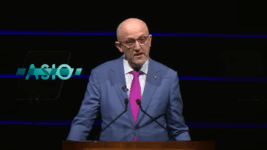Australia Is Facing Unprecedented Foreign Threats, With Three Nations Willing to Kill Locally

As he gave the 2025 Lowy Lecture on Gadigal land at Sydney Town Hall on 4 November 2025, ASIO director general Mike Burgess didn’t exactly convey a carefree future, as the spy boss warned of accelerating threats in three key areas: espionage, foreign interference and politically motivated violence. And on top of that, agents from three other nations are willing to murder on local soil.
According to Burgess, gone are the days when Australians could consider themselves living in isolation from the rest of the world, as foreign influence and overseas conflicts are impacting here both socially and with specific incidents, especially those related to Russia in Ukraine, “the conflict in the Middle East”, or the Israeli perpetrated Gaza genocide and in terms of China and Iran.
Foreign threats and “social dislocation” are not new to this country, Burgess underscored, and he noted the violence of the Frontier Wars, which involved the British invasion of First Peoples lands, as well as that over the 1960s through to the 1980s, key foreign conflicts were having an impact down under, which in its extreme, resulted in bombings in public places.
“But what we are seeing today is on a different scale, with different dynamics. Grievance is growing. Intolerance is rising. Inflammatory rhetoric and behaviour is being normalised. Anti-authority beliefs are spreading,” the spy boss warned last Tuesday night, and added that the internet is incubating grievances and conspiracies, which are being accelerated by social media and exacerbated by AI.
The top spy then continued with his trio theme to elaborate on “three distinct but connected cohorts” that are now intersecting to produce growing social discord, which are “the aggrieved”, “the opportunistic” and “the cunning”. And this, of course, ultimately signals a need to proactively surveil the public, with the ultimate aim of preventing foreign threats and the enemies within.
The wreckers of social fabric
“The aggrieved are the individuals who tear at our social fabric. The opportunistic are the organised groups that take advantage of weaknesses in our social fabric. The cunning are the nation states that play a longer, more calculated game to divide and distract us,” Burgess explained in respect of those seeking to destroy social cohesion. “Let’s start with the aggrieved.”
The aggrieved are those amongst us invested in political differences, debates and protest to the point of “polarisation and intolerance”. Increasing disaffection is fuelled by the erosion of social cohesion, declining institutional trust and assaults on the truth. This has led to “angry, alienated individuals” engaging in “uncivil debate and unpeaceful protest”, as well as creating “new hybrid ideologies”.
Burgess then raised sovereign citizens as an example of the aggrieved to make the point that not all of the aggrieved are on the same page, and to highlight these differences, he further explained that sovereign citizens consider the government has “no authority”, while other aggrieved actors think it “possesses too much authority”.
Some of the aggrieved don’t spout “violent views but may still see violence as a legitimate way to effect political or societal change”, and this trend that commenced during COVID, “gained further momentum after the terrorist attacks on Israel, and accelerated during Israel’s military response”, otherwise known as the 25-month-long Gaza genocide.
This tends to suggest that even though the Palestine solidarity movement has shown itself to be diverse and nonviolent over the last two years of its mobilisation nationwide, there may be actors within it that secretly assert the use of violence as legitimate.
The second purveyors of social discord are the opportunistic, who more precisely are the “extremists – whether religiously or ideologically motivated”. The key example that Burgess raises is the violent neo-Nazi organisation the National Socialist Network, “or White Australia as it is rebranding itself”, and its attempt to leverage broader support via the white nationalist March for Australia rallies.
Burgess assesses that the neo-Nazis were attempting to draw people into its broader Nazi agenda, via a shared concerns over social issues, such as “immigration and the cost of living”. The spy boss added that “modern neo-Nazis crave attention and publicity” and they regard journalists as “useful idiots”, as even the “most critical coverage” is appreciated as it results in a surge in membership.
The top spy further took a moment to make clear that “even if the organisation does not engage in terrorism” he remains “deeply concerned by its hateful, divisive rhetoric and increasingly violent propaganda, and the growing likelihood these things will prompt spontaneous violence, particularly in response to perceived provocation”.
Then Burgess highlighted that Gaza has fuelled other types of opportunistic extremists of the “anarchist and revolutionary” kind. He adds that there have been “multiple acts of arson, vandalism and violent protest against defence companies accused of supplying weapon components”. And these autonomous individuals working together are “increasingly willing” to get violent.
As an example of religious opportunists, well, according to the director, that would be local chapters of global Islamist organisation Hizb ut-Tahrir. Burgess likens its operations to those of the NSN neo-Nazis, as it explains that this group also dabbles in “provocative behaviour, offensive rhetoric and insidious strategy”, as it condemns “Israel and Jews” in the media to build its membership.
“I fear its anti-Israel rhetoric is fuelling and normalising wider antisemitic narratives,” Burgess threw in, adding that while he’s highlighted a trio of opportunists, there are certainly “further examples of the multi-directional and multi-dimensional challenge for Australia’s community fabric” in this current period of unprecedented threats.
“The final cohort”
The last wrecker of the social fabric is the cunning, who comprise of “nation states deliberately trying to set the fabric alight and fan the flames” and “is something else again in terms of threat”. Burgess elaborates that these regimes are operating in a “security ‘grey zone’” and utilising “non-traditional tools to interfere in decision-making, promote discord, amplify distrust and spread false narratives”.
“This is a newer and more disturbing dynamic, and why I say the threats facing our social cohesion are unprecedented,” the director general of ASIO made clear. “Authoritarian regimes demonstrate a chilling willingness to exploit fault lines in countries they consider hostile.”
Burgess then explained that the institute’s founder Frank Lowy had questioned in January, whether “dark forces financed by international hatred” could “be behind Australia’s spate of antisemitic incidents”. The ASIO boss didn’t mention that in March, the Australian federal police and the NSW police revealed that this spate was staged by organised crime to look like a crisis in Jewish hate.
Burgess then recalled that in August, PM Anthony Albanese announced that ASIO had uncovered that arson attacks on a Jewish deli in Bondi and another on a synagogue in Naarm-Melbourne were coordinated by the Iranian Islamic Revolutionary Guard Corps. He adds that the gig criminals lighting the fires probably didn’t know that. NSW police continues to deny any foreign interference however.
This is the most “egregious example” of the cunning, but there are others, which includes propaganda “advocating attacks on specific targets” that appears to relate to a “transnational terrorist group” but is suspected to be the work of a nation. Burgess then dwelt on the interference and influence of Russian agents both on the ground and online “justifying the invasion of Ukraine”.
“Attempt to assassinate”
“Given the degrading trajectory of our security environment and the growing willingness of regimes to conduct high-harm operations, ASIO assesses there is a realistic possibility a foreign government will attempt to assassinate a perceived dissident in Australia,” the spy boss warned. “This threat is real.”
“We believe there are at least three nations willing and capable of conducting lethal targeting here. It is entirely possible the regimes would try to hide their involvement by hiring criminal cutouts, as Iran did when directing its arson attacks,” Burgess added, in delivering this cherry on the cake. He further underscored that he said “attempt”, hinting at the fact that his agency will thwart any such attempt.
In summing up, the director general raised once again “antisemitism” suggesting it had been a problem prior to Iran directing “it’s arson attacks” on local soil and then affirmed that Tehran was behind “at least two of the incidents, it is not responsible for every incident”.
But as for which nation states have been assessed as willing to kill people on local soil for political purposes, that’s obviously something the public may learn after the fact.







